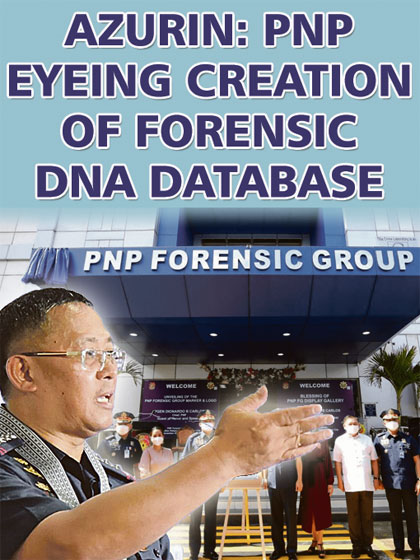
Azurin: PNP eyeing creation of forensic DNA database
 THE Philippine National Police (PNP) headed by General Rodolfo S. Azurin Jr. this year is pushing for the establishment of a Forensic DNA Database in the country as part of its continuing efforts to really become a world-class police force that can arrest and jail or help set free a wrongly convicted person thru his/her DNA sample, the Journal Group learned.
THE Philippine National Police (PNP) headed by General Rodolfo S. Azurin Jr. this year is pushing for the establishment of a Forensic DNA Database in the country as part of its continuing efforts to really become a world-class police force that can arrest and jail or help set free a wrongly convicted person thru his/her DNA sample, the Journal Group learned.
As part of their efforts, the PNP chief has sought the assistance of the House of Representatives headed by Speaker Ferdinand Martin T. Romualdez and the Senate headed by Senate President Juan Miguel ‘Migz’ F. Zubiri in approving their proposed legislative agenda which is their 4th highest priority in 2023.
The PNP leadership believes that DNA evidence and collection is among the most valuable pieces of evidence used in criminal cases since no two people — except for twins — have the same DNA, meaning the use of such evidence can either prove a person’s innocence or guilt with great accuracy.
The plan, if approved will greatly help the police force investigate and solve crimes such as rape, murder, theft and robbery and even terror bombings where no suspect has been identified by witnesses or caught.
PNP Director for Plans, Major Gen. Bernard M. Banac said they are calling on the 19th Congress to approve their proposal to create and establish a centralized and nationwide DNA database system for the collection, storage and maintenance of genetic identification information.
The measure also aims to empower pertinent government agencies to collect, analyze, type or profile and record any and all genetic markers contained in or derived from DNA.
Lastly, it is also meant to perform comparative searches for the purposes of serving as a tool for crime prevention and crime solution, identifying persons who might have been involved in the commission of an offense, proving the innocence or guilt of person allegedly involved in the commission of an offense, exonerating a person wrongly convicted of an offense, or assisting in the identification of missing persons or unidentified human remains.
Maj. Gen. Banac said the salient features of the PNP National Forensic Database include the following: indices in the database: crime scene index, arrested person index, convicted offenders index, detainee index, elimination person index, law enforcement personnel index, military personnel index, missing person index, street children and beggars index, unidentified human remains index and voluntary person index.
As proposed by the PNP to the 19th Congress, the PNP Forensic Group DNA Laboratory Division will manage the DNA databases established banking on the use of expert testimony or evidence relating to the use of biological sample or genetic markets contained in or derived from DNA for identification as evidence in any court proceedings.
In modern countries like the United States, there have been a number of wrongly-imprisoned persons who have been set free as a result of DNA examination.
In cases where a suspect has not yet been identified, biological evidence from the crime scene are analyzed and compared to offender profiles in DNA databases o help identify the perpetrator.
Crime scene evidence can also be linked to other crime scenes thru the use of DNA databases.
If DNA technology could prove people guilty of crimes, it could also prove that people who have been wrongfully convicted were innocent. This as research showed that 99.9 percent of human DNA is identical but that .1 percent can be used in forensic labs to differentiate one individual from another.
Experts are also saying that DNA is a very powerful investigative tool because, with the exception of identical twins, no two people have the same DNA. Therefore, DNA evidence collected from a crime scene can be linked to a suspect or can eliminate a suspect from suspicion.
In the U.S., DNA evidence is expected in every case by 22 percent of the jurors, in murder cases by 46 percent; in assault cases by 28 percent; in rape cases by 73 percent; in breaking entering cases by 18 percent; in theft cases by 12 percent; and in crimes involving a gun by 17 percent.
Many celebrated ‘cold cases’ including those involving serial killers and rapists in the U.S. were also solved with the help of DNA since their police departments have been heavily funded to identify, review, investigate and analyze violent crimes including ‘cold cases’ that could be solved thru DNA.

















